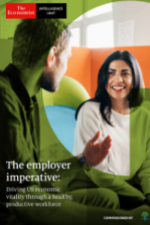
The past 18 months have been difficult on many different levels – particularly for the workforce. One bright spot we saw was the way in which many organizations – both big and small – stepped up to empower and support their people through this unprecedented time.
Indeed, employers took on the role of a trusted advisor throughout the pandemic, a remarkable shift from how things used to be. From new health benefits, to new strategies for keeping people safe and healthy, there’s been no shortage in innovation around employee experience since the start of the pandemic – and rightfully so. Research by the Economist, which was sponsored by Cigna, has found that healthy employees are more productive, and businesses with productive employees generate more revenue, broader economic growth and community vitality.
This was the topic of Cigna’s recent webinar, “Why Employee Health Matters and What Employers Can Do,” where John Murabito, EVP and chief administrative officer of Cigna, was joined by panelists from Accenture, Economist Impact and the Business Group on Health, to discuss the importance of workforce health and well-being.

Watch the Healthy Workforce Webinar On-Demand Now
Hear experts from Cigna, Accenture, Economist Impact, and Business Group on Health speak to employee expectations in today’s hybrid work environment, the impact of stress and burnout on business growth, as well as best practices leading organizations are using to manage employee health and well-being.
Read on for some of the most interesting takeaways from their conversation, and for tips on how to prioritize and invest in the health and well-being of the American workforce. (Editor’s note: some quotes have been lightly edited for length and clarity.)
The Role of Employers in Driving U.S. Economic Vitality Through a Healthy, Productive Workforce
According the aforementioned Cigna/Economist study, 92% of companies believe that employers play a critical role in encouraging healthy behaviors from employees.
 “We found that it is important that employers make well-being a core part of their business strategy,” said David Humphreys, global head of health policy and clinical evidence for Economist Impact. “Our research indicates different ways to put this into action. We found adopting a flexible and agile approach is essential to supporting employee engagement.”
“We found that it is important that employers make well-being a core part of their business strategy,” said David Humphreys, global head of health policy and clinical evidence for Economist Impact. “Our research indicates different ways to put this into action. We found adopting a flexible and agile approach is essential to supporting employee engagement.”
On average, the research found that companies with high employee engagement are 23% more profitable. De-stigmatizing wellness needs and creating a “culture of health” to encourage use of benefits is also crucial for ensuring the economic impact of well-being, Humphreys added. “There are many measurable benefits that stem from a healthier workforce… employer-driven health interventions can result in a 76% return-on-investment due to productivity increases and healthy employees result in 70% fewer work days missed over a year. “
How the COVID-19 Pandemic Impacted Workforces: Lessons Learned
According to Ellyn Shook, chief leadership and human resources officer at Accenture, the pandemic exposed “multiple compounding crises.” The world, she said, declared a global health pandemic. But it quickly became a global financial crisis, and a social and mental health crisis that was affecting different populations in very different ways.
 "Think about working parents and people living in communities experiencing sickness and death in a disproportionate way,” Shook said. “It was a very significant impact on our workforce, and one we needed to quickly deal with. We learned many, many lessons, particularly by listening to our people.”
"Think about working parents and people living in communities experiencing sickness and death in a disproportionate way,” Shook said. “It was a very significant impact on our workforce, and one we needed to quickly deal with. We learned many, many lessons, particularly by listening to our people.”
Although Accenture has worked in a hybrid manner for a long time, this was truly the first time where everyone had to work through digital platforms, which Shook says underscored a need for human connection like never before.
“We learned very quickly, the more digital the world became, the more human connection became more important,” she told webinar attendees.
Additionally, leaders needed to lead differently, with not just empathy but with true compassion, throughout the pandemic, and she doesn’t expect the need for this leadership characteristic to dissipate after COVID—it’s here to stay.
 According to Cigna's Murabito, the pandemic has also underscored the need for flexibility in the workplace, which has had a real impact on employee engagement and mental health.
According to Cigna's Murabito, the pandemic has also underscored the need for flexibility in the workplace, which has had a real impact on employee engagement and mental health.
“It’s become a challenging time, people can be going through a number of things – new parents, marriage, divorce – leaders must learn to listen, passionately and empathetically, to find the right level of flexibility,” said Murabito. “Employers that really care about the health and well-being of their people are going to understand that this flexibility has an important impact on employee engagement and mental health.”
 LuAnn Heinen, VP of Business Group on Health, echoed Murabito’s sentiment, and added that today’s leaders must prioritize the mental health of their employees. In fact, she added, new data from her organization finds that the pandemic has increased employee well-being initiatives and programs, with a whopping 92% of employers expanding their programs in 2021. Many of these programs were designed to solve for mental health, stress, and burnout.
LuAnn Heinen, VP of Business Group on Health, echoed Murabito’s sentiment, and added that today’s leaders must prioritize the mental health of their employees. In fact, she added, new data from her organization finds that the pandemic has increased employee well-being initiatives and programs, with a whopping 92% of employers expanding their programs in 2021. Many of these programs were designed to solve for mental health, stress, and burnout.
Culture of Health
Shook said Accenture's journey started six years ago with its aspiration to become the most truly human company in the digital age. And that simply means that “we were going to help people achieve their aspirations both professionally and personally,” she said, adding that listening intently to its people and acting on their expressed needs is at the heart of what employee wellness is all about at Accenture.
According to Cigna's Murabito, CEOs and their leadership team have a unique responsibility to foster a culture committed to employee health.
“…We have the opportunity to make employee health and well-being a priority for the organization,” he said, highlighting that a company’s purpose should ground its well-being strategy. For Cigna, Murabito said, incentives are a really important employee wellness strategy, rewarding employees across a lot of different dimensions of well-being.
According to Heinen, employee health and well-being has grown to mean much more than just benefits. It’s stretching across the organization, she said, touching on diversity, equity, and inclusion, among other strategies. Business Group on Health found that nine out of 10 HR and benefits leaders now say their well-being strategy is fundamental to, or part of, their overall business strategy.
“Well-being is now critical to the employee experience, as well as to the employer value proposition,” Heinen said. “Studies show that when managers support [employee] well-being, employees are more likely to report they’re happy with their job and to recommend their company. And another change I’ll flag – for the first time in our surveys, this year – containing health care cost, is no longer the top objective of these programs. This signals a significant shift, and employee engagement is now the No. 1 objective.”

The Employer Imperative: Driving US Economic Vitality Through a Healthy, Productive Workforce
Research from the Economist/Cigna finds employers are the key to linking employee health and productivity, business success, and overall economic vitality.